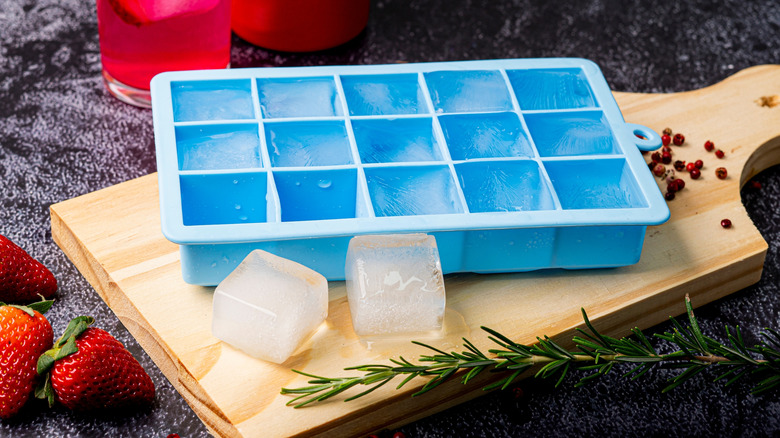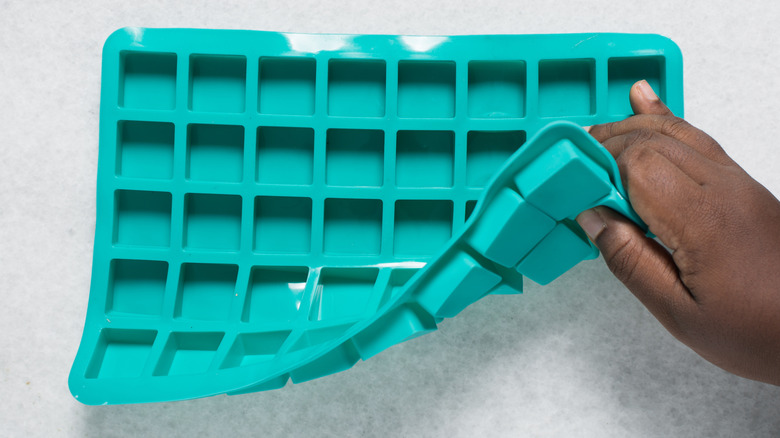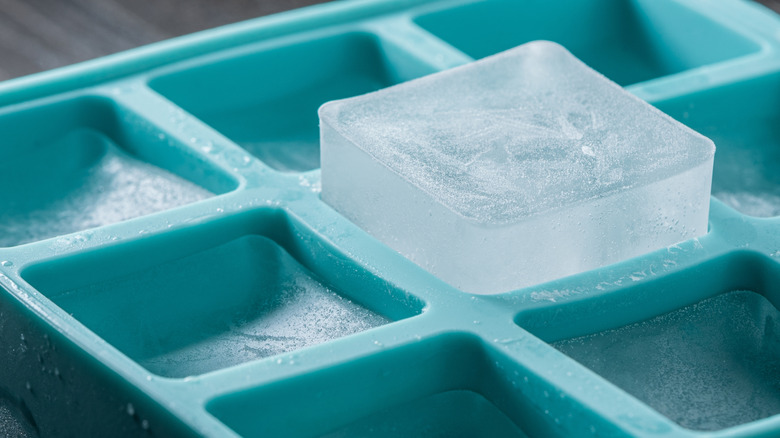The Drawback Of Silicone Ice Molds That You Should Know
The innovation of silicone ice molds was surely a welcome one. They're much more durable than their predecessors, and their flexibility makes releasing ice much easier than it is with standard hard plastic trays, which are prone to breakage from being twisted to free their contents. Despite these benefits, however, there are some drawbacks to silicone molds, as Mike Ryan, corporate director of beverage for Tanta Chicago and Acurio International, shared in an exclusive discussion with Food Republic.
The main feature that makes silicone trays preferable — their flexibility — is also the very thing that can cause issues. "Silicone is great," Ryan said, adding, "easy to clean, easy to un-mold your ices." But there's a catch: "The only drawback is rigidity — water expands as it freezes, so your silicone molds may deform a bit as you're freezing them." Extensive use and the passage of time can impact the integrity of a silicone tray, resulting in the product's shape permanently altering from the constant expansion and contraction of freezing and removing ice. For the same reason, these molds are also sometimes known to tear as they age. They can become further deformed just from being stored in a cupboard or container if they're packed away in a compressed position or with another item putting weight on them.
If you're not particular about uniformity in the shape of your ice cubes, eventual deformities may not be a dealbreaker. If you have novelty silicone trays designed to create specialty shapes, however, deformation will be more of a concern. A semicircle mold, for instance, which is designed to produce round ice (also great for making the ultimate hot chocolate bomb) won't be much use when it's no longer proportionately shaped.
Other silicone ice mold disadvantages
A silicone ice tray's flexibility is also a blessing and a curse in terms of usability. While the product is longer-lasting than its plastic forerunners, it doesn't have their stability, which becomes painfully noticeable when you attempt to move the filled trays to the freezer. Their floppy construction, which makes releasing ice so much easier, can result in easy spillage when refilling, requiring extra steps like using a baking tray to stabilize and transport the molds, or purchasing specialty silicone ice trays that come with lids to help prevent spills (though these aren't failsafe and can still result in leakage).
Alternative fill-up methods may be less convenient than replenishing your trays at the kitchen faucet, but they'll prevent potential spillage while you carry the trays to the freezer. One option is using a pitcher or sports bottle to fill the molds right inside your freezer, so no transportation is needed while their contents are still in liquid form. This, of course, requires adequate clearance between your tray and the top of the appliance to fit the pouring container, so the feasibility of this hack will depend on your refrigerator's design. A pullout freezer drawer makes this tip easier to execute, as there's no freezer ceiling to contend with while filling your trays.
Prolonging the life of your silicone ice molds
Whether you like to plunk ice into your drinks on a hot day, blend it up in your favorite smoothies, or use it as the secret ingredient for better grilled cheese, it's nice to have some on hand, which is why most people keep a tray or two sitting in the freezer if their refrigerator doesn't have an ice maker. The disadvantages of the superior-to-its-forebears-but-definitely-not-perfect silicone tray, therefore, may seem discouraging. However, there are things you can do to both prolong the life of your silicone molds and help prevent ice disfiguration.
The first consideration is proper care. Always follow the manufacturer's recommendations, and don't expose your silicone trays to higher temperatures than the maker advises. You should also adhere to the producer's advice in terms of cleaning the molds. Just how are you supposed to clean ice cube trays? We're glad you asked! Washing them by hand may be preferable to sticking them in a dishwasher, so check the instructions for your particular product. When in doubt, hot water and soap is always a safe approach — allow some extra soak time if you need to get rid of absorbed odors. Above all, avoid harsh cleaning chemicals.
Proper storage is another factor to consider. When your molds aren't in use, they should be stored away from heat and out of direct sunlight. As previously mentioned, you should also make sure they aren't stored in a malformed position or compressed by the weight of other objects, as this can permanently warp their shape.



